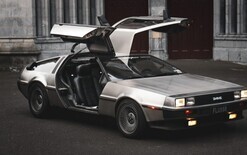World’s first car that can ‘fly and drive’
Flying cars have been a staple of science fiction for years, but as more firms strive to make that vision a reality one such vehicle has gone on display during Miami Art Week.
A prototype of the Pioneer Personal Air Landing Vehicle (PAL-V) Pioneer flying car, which is a mix of Dutch engineering and Italian design, was unveiled in the US on December 3.
The flying car features retractable overhead and rear propellers and tail wings, allowing it to drive on the ground like a car, and take to the skies like a plane.
On the ground, the car can reach top speeds of 160kph, while in the sky it can soar at 180kph. It is designed to carry two people and the makers claim it can accelerate on the road from 0-100kph in under nine seconds and has a fuel economy of 7.6l/100km.
The vehicle converts from a three-wheeled car to a gyrocopter in just 10 minutes and can cruise at an altitude of 3,500m, with a full tank of fuel keeping it airborne for more than four hours.
It is made of carbon fibre, titanium and aluminium and requires a 330m runway for take-off and just 30m for landing. The craft has a similar handling system to that of a motorbike, which relies on the driver tilting the vehicle with a control stick on the ground and in the air.
Mike Stekelenburg, chief engineer at PAL-V, says: “Although more and more flying concepts are announced, only a handful of companies work on a real flying car: one that can both fly and drive, ideal for city-to-city mobility.
“The combination offers unprecedented freedom: personal door-to-door flying mobility. The gyroplane principle not only provides us with a safe and easy to operate flying car but it also enables us to make it compact and within existing regulations, which is the most important factor to build a useable flying car.”
While a prototype was shown in Miami, a commercial version is already in production. It will come with a price tag of about NZ$850,000, but its designers claim to have pre-sold 70 vehicles and hopes to start delivering them in 2021.









